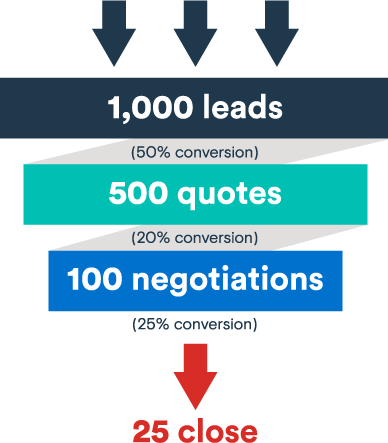6 steps to improving your sales process
Imagine your sales manager were to leave your business tomorrow. Would you know how many sales are about to close? Would you know how much revenue to expect next month? Would you know how much it costs you to acquire a customer?
If you answered no to any of these questions, then it’s probably time to create or update you sales process.
“Your sales process defines steps to be followed and roles for team members,” says BDC Senior Business Advisor Chris O’Shea. “Putting it down on paper allows you to plan, forecast, evaluate performance and optimize what you do.”
O’Shea, who works with entrepreneurs to improve their sales and marketing performance, says entrepreneurs can follow these six steps to improve their sales process.
1. Map out your current processes
Most companies have an informal sales process, where everyone sort of knows what is supposed to happen and who does what.
The first thing you’ll want to do is map out these informal processes to get a formal understanding of all the steps to making a sale.
“How many emails do you need to send? How many phone calls are you making? Who are you talking to? Whatever the building blocs of the sale are, we have to define those and that becomes our process,” O’Shea says.
Examples of sales process steps include:
- generating leads
- sending proposals
- negotiations
- sales confirmation
- delivery
- receiving final payment
2. Define your key performance indicators (KPI)
Writing down your processes will allow you to track prospects as they advance from one step to the next. This will allow you to measure how many leads successfully move through your pipeline. You’ll also know how long it takes to complete a sale on average from start to finish.
“If you talk to 100 leads next month, how many leads will move onto the next step? Is it 50%? 10%? You can measure that and use it as a KPI,” O’Shea says.
You can also measure service turnaround time. If it usually takes Steve and the sales team two days to turnaround a quote and all of a sudden it turns into 10 days, then that’s a big problem and we need to fix that.”
Common KPIs include:
- sales to date this month
- sales to date this year
- overall time in the sales cycle
- closing rate
- burn rate (How much money you are spending in your sales process.)
- average sales price
- lifetime customer value
- customer acquisition cost
- churn rate (How many customers repurchase your services or products.)
3. Follow-up and measure performance
Holding sales meetings is a good way to ensure a regular review of sales data. The goal of the meeting should be to determine what opportunities are in the pipeline and how leads are moving through the process.
Your KPIs can also be used to measure individual performance. Employees generally appreciate the transparency of knowing how they are judged. It can also be a great way to foster friendly competition within your team.
“The data gives you clarity and purpose at the sales management level,” O’Shea says. “Why is my guy just sitting at his desk? Why isn’t he on the road? If you have a process by which to judge behaviours and accomplishments then you are no longer asking those questions.”
Data collection and its management is a habit you have to stick with. Otherwise you won’t have that window into how your sales are going.
Chris O’Shea
BDC Senior Business Advisor
4. Use technology to simplify monitoring
Your next step should be to centralize all your client and contact information. This database can take the simple form of a spreadsheet, but as your business grows, you will probably want to invest in customer relationship management software (CRM).
“Ten years ago the cost of CRM was prohibitive, or they were complicated, but that’s not the case anymore,” O’Shea says. “The bigger ones all have scaled back versions that can get you started recording data and mapping your sales process.”
A good CRM system will:
- store all your contact information in one place
- allow better sharing and communication of information across your team
- help manage your activities tasks and steps in the process
- automate the tracking of your KPIs
Consult our list of free and low cost CRMs for your business.
5. Start forecasting your sales
You can think of your processes as a funnel or pipeline. By measuring your conversion rate at every step, you’ll be able to determine the inputs you need to achieve your sales goals.
“If we talk to 100 people and know we can close 10 of them, the math gets pretty easy,” O’Shea says. “But you have to be doing the math and measuring all this stuff. Otherwise you’re guessing.”
One trick is to think of your sales funnel as a reverse pyramid. If 50% of your leads move on to the quote stage, 20% go on to the negotiations stage and 25% close, then you know that you need to talk to 1,000 leads to sell 25 units.

6. Increase your sales
After you’ve mapped your processes and established a forecast, it becomes simple enough to increase your sales. You can calculate that to get X amount of sales you will need to spend X amount of money to increase the number of prospecting calls or pay-per-click advertisement to get more leads in your pipeline.
However, you might be better served by working to optimize your existing processes. This is usually done by:
- Increasing your average order size (sell more stuff)
Consider offering discounts for larger orders, free shipping for orders over a certain threshold, or upselling and cross-selling items.
- Improving your conversion rate (sell more often)
For example, you can tweak your sales script, create offers that are more appealing and provide additional training to your sales staff.